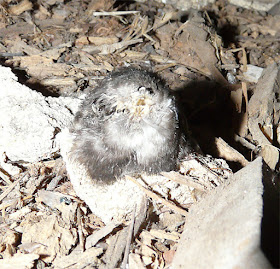I was recently contacted by a representative of the RSPB to see if I would be able to help resolve an issue with common swifts getting into a local church. This is an issue that has been happening over the last couple of years; and involves birds from the breeding colony at the church somehow getting into the church itself, becoming exhausted and dying. I was asked to attend because as well as breeding swifts, there are also roosting bats, and it was imperative that whatever plan of action was to be designed, it must help the swifts but not impact on the bats. The church dates from Norman times and is constructed with brick and flint, with a clay tiled roof, the side elevations of the bell tower are clad with wooden shingles and again it has a clay tiled roof.
 |
| Dead Common Swift, Peacock Butterfly wings and Cluster Flies |
I had to access the bell tower by-way of a long ladder and a small wooden door, which led to a small set of steps, and then into the first floor of the bell tower. I counted at least five dead swifts scattered in various locations in this area, along with several wings from peacock butterflies and hundreds of bat droppings and cluster flies Pollenia species.
 |
| Swift Head positioned upright on a Stone |
There was also a reasonable amount of rodent activity in the bell tower, and some of the swift corpses had been eaten. Eerily, the head of one of the dead swifts was upright on a piece of plaster, I'm not really sure whether someone had positioned it like that or it had just ended up like that after being knocked/gnawed by rodents, probably the latter since its beak was missing.
 |
| Decomposed Swift with Flat Fly Pupae |
I was rummaging around trying to find, where swifts were getting into the tower and how they were getting into the church. But as I was doing so I came across a decomposed swift with several small black pellets lying around it. I have seen these before when I have ringed swifts in the nest and know them to be the pupa of the flat-fly parasite Crataerina pallida which is host specific to swifts.
 |
| Crataerina pallida Pupa |
The adult flat-fly is a blood sucking parasite which does not lay an egg, instead it broods the eggs internally, lays a fully formed larva that immediately starts to pupate. When the pupa hatches in the following year, it will try to seek out an adult bird or associate itself with a nest.
I did manage to find how swifts were getting into the church, and have hopefully resolved that problem but will need to go back in the summer and see how they are getting into the bell tower. My aim will be to try a stop the swift becoming trapped in the first place, but in doing that I don't want to stop bats getting in, I will keep you posted....
No comments:
Post a Comment